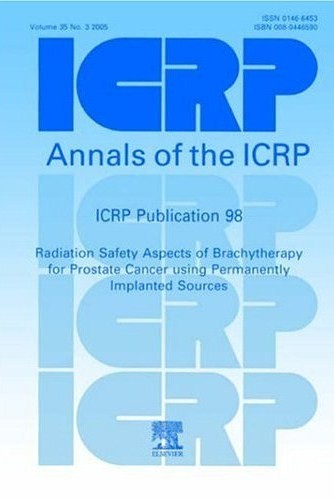ICRP Publication 98
Radiation Safety Aspects of Brachytherapy for Prostate Cancer using Permanently Implanted Sources
Recommended citation
ICRP, 2005. Radiation Safety Aspects of Brachytherapy for Prostate Cancer using Permanently Implanted Sources. ICRP Publication 98. Ann. ICRP 35 (3).
Abstract - The use of permanent radioactive implants (I-125 or Pd-103 seeds) to treat selected localised prostate cancer patients has been increasing rapidly all over the world for the last 15 years. It is estimated that more than 50,000 patients are treated this way every year in the world, and this number is anticipated to increase in the near future.
Although no accidents or adverse effects involving medical staff and/or members of the patient's family have been reported to date, this brachytherapy technique raises a number of radiation safety issues that need specific recommendations from the ICRP.
All data concerning the dose received by people approaching patients after implantation have been reviewed. Those doses have been either been measured directly or calculated. The available data show that, in the vast majority of cases, the dose to comforters and carers remains well below the recommended limit of 1 mSv/year. Only the (rare) case where the patient's partner is pregnant at the time of implantation may need specific precautions.
Expulsion of sources through urine, semen, or the gastro-intestinal tract is rare. Specific recommendations should be given to patients to allow them to deal adequately with this event. Of note, due to the low activity of an isolated seed and its low photon energy, no incident/accident linked to seed loss has ever been recorded.
When performed in the first few months after implantation, cremation of bodies (frequent in some countries) raises several issues related to: (1) the activity that remains in the patient's ashes; and (2) the airborne dose, potentially inhaled by crematorium staff or members of the public. Review of available data shows that cremation can be allowed if 12 months have elapsed since implantation with I-125 (3 months for Pd-103). If the patient dies before this delay has elapsed, specific measures must be undertaken.
Specific recommendations have to be given to the patient to warn his surgeon in case of subsequent pelvic or abdominal surgery. A 'wallet card' with all relevant information about the implant is useful.
In most cases, brachytherapy does make the patient infertile. However, although the therapy-related modifications of the semen reduce fertility, patients must be aware of the possibility of fathering children after such a permanent implantation, with a limited risk of genetic effects for the child.
Patients with permanent implants must be aware of the possibility of triggering certain types of security radiation monitors. The 'wallet card' including the main information about the implant (see above) may prove to be helpful in such a case.
Considering the available experience after brachytherapy and external irradiation of prostate cancer, the risk of radio-induced secondary tumours appears to be extremely low. The demonstrated benefit of brachytherapy clearly outweighs, by far, the very limited (mainly theoretical) increase in the radiation-induced cancer risk.
ICRP, 2005. Radiation Safety Aspects of Brachytherapy for Prostate Cancer using Permanently Implanted Sources. ICRP Publication 98. Ann. ICRP 35 (3).
Abstract - The use of permanent radioactive implants (I-125 or Pd-103 seeds) to treat selected localised prostate cancer patients has been increasing rapidly all over the world for the last 15 years. It is estimated that more than 50,000 patients are treated this way every year in the world, and this number is anticipated to increase in the near future.
Although no accidents or adverse effects involving medical staff and/or members of the patient's family have been reported to date, this brachytherapy technique raises a number of radiation safety issues that need specific recommendations from the ICRP.
All data concerning the dose received by people approaching patients after implantation have been reviewed. Those doses have been either been measured directly or calculated. The available data show that, in the vast majority of cases, the dose to comforters and carers remains well below the recommended limit of 1 mSv/year. Only the (rare) case where the patient's partner is pregnant at the time of implantation may need specific precautions.
Expulsion of sources through urine, semen, or the gastro-intestinal tract is rare. Specific recommendations should be given to patients to allow them to deal adequately with this event. Of note, due to the low activity of an isolated seed and its low photon energy, no incident/accident linked to seed loss has ever been recorded.
When performed in the first few months after implantation, cremation of bodies (frequent in some countries) raises several issues related to: (1) the activity that remains in the patient's ashes; and (2) the airborne dose, potentially inhaled by crematorium staff or members of the public. Review of available data shows that cremation can be allowed if 12 months have elapsed since implantation with I-125 (3 months for Pd-103). If the patient dies before this delay has elapsed, specific measures must be undertaken.
Specific recommendations have to be given to the patient to warn his surgeon in case of subsequent pelvic or abdominal surgery. A 'wallet card' with all relevant information about the implant is useful.
In most cases, brachytherapy does make the patient infertile. However, although the therapy-related modifications of the semen reduce fertility, patients must be aware of the possibility of fathering children after such a permanent implantation, with a limited risk of genetic effects for the child.
Patients with permanent implants must be aware of the possibility of triggering certain types of security radiation monitors. The 'wallet card' including the main information about the implant (see above) may prove to be helpful in such a case.
Considering the available experience after brachytherapy and external irradiation of prostate cancer, the risk of radio-induced secondary tumours appears to be extremely low. The demonstrated benefit of brachytherapy clearly outweighs, by far, the very limited (mainly theoretical) increase in the radiation-induced cancer risk.
